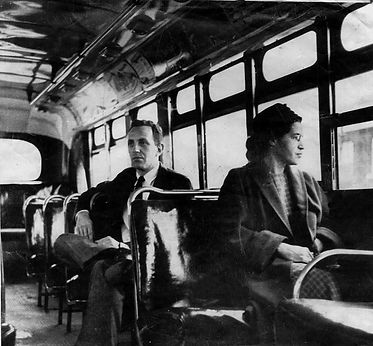Jesse Cumbia
Where and when did the protest take place?
The Montgomery Bus Boycott took place in Montgomery, Alabama. The boycott began on December 5, 1955, and lasted until December 20, 1956. (History.com)
Who were the leaders of the protests?
Rosa Parks was the leader who initiated the boycott. After Parks’ arrest several of Montgomery’s black leaders founded the Montgomery Improvement Association. (Brinkley) The MIA was formed with the main initial cause of protesting the arrest of Rosa Parks, who was a NAACP official. The Montgomery Improvement Association appointed Dr. Martin Luther King Jr. as the head. King’s main role was as spokesman of the Boycott. (The King Center)
What were their goals?
The initial goal was to end racial segregation of the public buses. By starting a boycott they intended to cause the bus companies to economically decline until they had the choice of either going out of business or lifting the segregation laws. (History.com) The fundamental goal was to end segregation completely, this caused the beginning of the civil rights movement which had the intent of nonviolently protesting for equal rights for all. (Brinkley)
Summary:
On December 1, 1955, Rosa Parks, while riding on a public city bus, refused to give up her seat to a white man. Being an African American Parks’ actions broke segregation laws and she was fined and arrested. Parks’ arrest sparked the beginning of the boycott which was the day of Parks’ court hearing on December 5, 1955. (History.com) The entire population of African Americans living in Montgomery boycotted the public buses and either walked or rode with other African Americans in an unofficial taxi service. The boycott lasted 381 days. (History.com) On June 5, 1956, the segregated seating on buses was found as violating the 14th Amendment by a Montgomery federal court. Montgomery appealed to the Supreme Court which upheld their ruling. The buses were integrated and on December 21, 1956, the Montgomery Bus Boycott ended. (Brinkley)
Results:
The Montgomery Bus Boycott was a huge success. It ended the racial segregation of the buses which sparked the spread of the end of segregation. It also caused the beginning of the Civil Rights Movement. It was also the start of Dr. Martin Luther King Jr’s leadership of the Civil Rights Movement. (The King Center) This boycott was important and significant because of the principals it was against, and the results it produced.
Bibliography:
Brinkley, Alan. The Unfinished Nation: A Concise History of the American People. Boston: McGraw-Hill, 2010. Print.
"The Bus Boycott Sparks a Movement." Donate Today and Get Involved. N.p., n.d. Web. 22 Apr. 2016. <http://www.thekingcenter.org/bus-boycott-sparks-movement>.
History.com Staff. "Montgomery Bus Boycott." History.com. A&E Television Networks, 01 Jan. 2010. Web. 22 Apr. 2016. <http://www.history.com/topics/black-history/montgomery-bus-boycott>.
Images:
Montgomery Bus Boycott. Digital image. Capitalandmain.com, n.d. Web. <http://capitalandmain.com/wp-content/blogs.dir/13/files/2016/01/Montgomery.jpg>.
Montgomery Bus Boycott. Digital image. N.p., n.d. Web. <http://wkrg.com/2015/11/30/anniversary-of-the-montgomery-bus-boycott/>.
Montgomery. Digital image. Black Past. Blackpast.org, n.d. Web. 21 Apr. 2016. <http://www.blackpast.org/files/blackpast_images/bus_boycott.jpg>.


